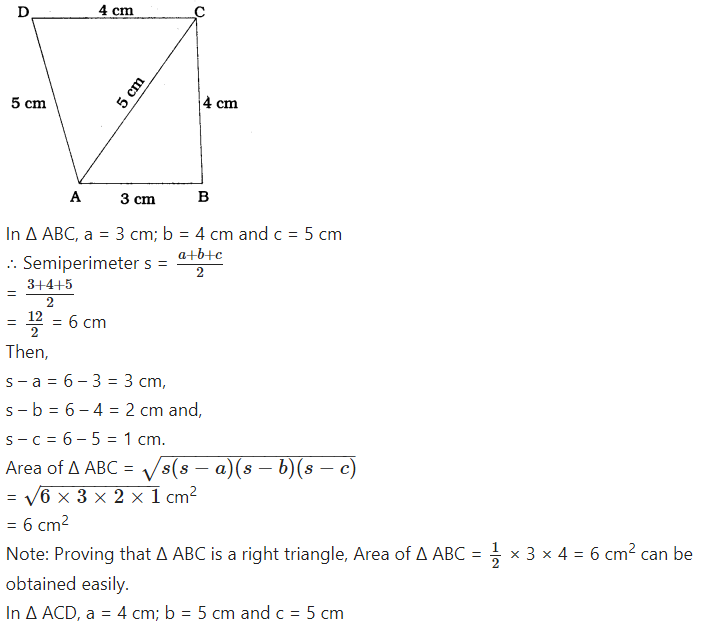PSEB Solutions for Class 9 Maths Chapter 12 Heron’s Formula Ex 12.2
PSEB Solutions for Class 9 Maths Chapter 12 Heron’s Formula Ex 12.2
PSEB 9th Class Maths Solutions Chapter 12 Heron’s Formula Ex 12.2
Question 1.
A park, in the shape of a quadrilateral ABCD has ∠C = 90°, AB = 9 m, BC = 12 m, CD = 5 m and AD = 8 m. How much area does it occupy?
Answer:

In ∆ BCD, ∠C = 90°
∴ BD2 = BC2 + CD2
= (12)2 + (5)2
= 144 + 25
= 169
= (13)2
∴ BD = 13 m


Question 2.
Find the area of a quadrilateral ABCD in which AB = 3 cm, BC = 4 cm, CD = 4 cm, DA = 5 cm and AC = 5 cm.
Answer:


Question 3.
Radha made a picture of an aeroplane with coloured paper as shown in the given figure, s Find the total area of the paper used. ;



The right triangle in part V is congruent to the right triangle in part IV.
∴ Area of right triangle in part V = 4.5 cm2
Now, total area of the paper used
= Areas of figures in part I to part V
= (2.5 + 6.5 + 1.3 + 4.5 + 4.5) cm2
= 19.3 cm2
Question 4.
A triangle and a parallelogram have the same base and the same area. If the sides of the triangle are 26 cm, 28 cm and 30 cm, and the parallelogram stands on the base 28 cm, find the height of the parallelogram.

Question 5.
A rhombus shaped field has green grass for 18 cows to graze. If each side of the rhombus is 30 m and its longer diagonal is 48 m, how much area of grass field will each cow be getting?
Answer:


Question 6.
An umbrella is made by stitching 10 triangular pieces of cloth of two different colours (see the given figure), each piece measuring 20 cm, 50 cm and 50 cm. How much cloth of each colour is required for the umbrella?

Answer:
Out of 10 triangular pieces, 5 are dark coloured and 5 are light coloured.
For each triangle, a = 20 cm, b = 50 cm and c = 50 cm

Hence, the total area of 5 dark coloured cloth pieces = 5 × 200 √6 cm2 = 1000 √6 cm2
Similarly, the total area of 5 light coloured cloth pieces = 5 × 200 √6 cm2 = 1000 √6 cm2
Question 7.
A kite in the shape of a square with a diagonal 32 cm and an isosceles triangle of base 8 cm and sides 6 cm each is to be made of three different shades as shown in the given figure. How much paper of each shade has been used in it?

Answer:
Let us name the square part as ABCD and the triangular part as CMN.
Suppose the length of square ABCD is xcm.
∴ In ∆ ABD, AB = AD = x cm and ∠A = 90°
The length of hypotenuse BD is given to be 32 cm.
AB2 + AD2 = BD2 (Pythagoras’ theorem)
∴ (x)2 + (x)2 = (32)2
∴ 2x2 = 1024
∴ x2 = 512
∴ x = √512


Question 8.
A floral design on a floor is made up of 16 tiles which are triangular, the sides of the triangle being 9 cm, 28 cm and 35 cm (see the given figure). Find the cost of polishing the tiles at the rate of 50 p per cm2.

Answer:
For each of 16 triangular tiles,
a = 9 cm; b = 28 cm and c = 35 cm

= 88.2 cm2 (approx.)
∴ Area of 16 tiles = 16 × 88.2 cm2
= 1411.2 cm2
50 paise = ₹ 0.50
Cost of polishing 1 cm2 region = ₹ 0.50
∴ Cost of polishing 1411.2 cm2 region
= ₹ (1411.2 × 0.50)
= ₹ 705.60
Question 9.
A field is in the shape of a trapezium whose parallel sides are 25 m and 10 m. The non-parallel sides are 14 m and 13 m. Find the area of the field.
Answer:

In the given figure, trapezium ABCD represents the field in which AB || CD,
AB = 25 m, BC = 14 m, CD = 10 m and DA = 13 m.
Through C, draw a line parallel to DA to intersect AB at E.
In quadrilateral AECD, AE || CD and DA || CE
∴ AECD is a parallelogram.
∴ CE = DA = 13 m and AE = CD = 10 m
Now, BE = AB – AE = 25 – 10 = 15 m
In ∆ CEB, a = 13 m; b = 15 m and c = 14 m


Follow on Facebook page – Click Here
Google News join in – Click Here
Read More Asia News – Click Here
Read More Sports News – Click Here
Read More Crypto News – Click Here